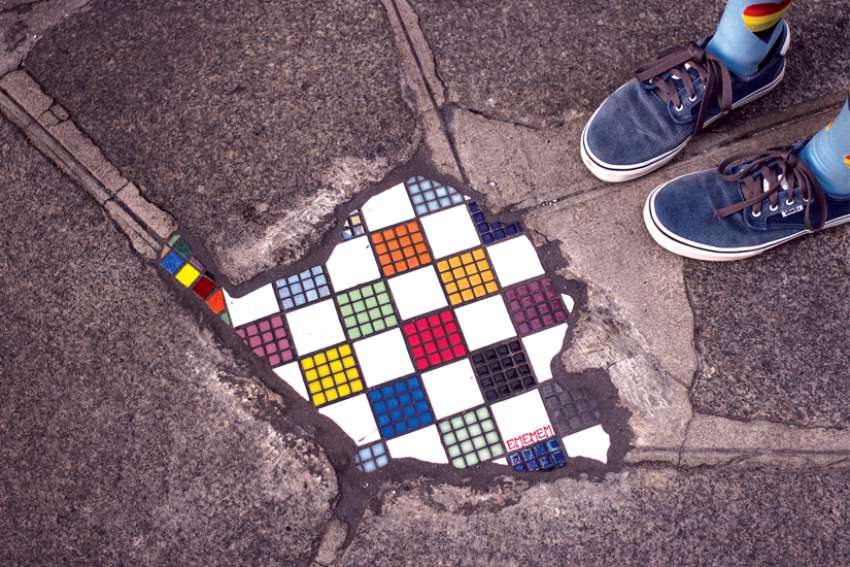An artist in France has adopted an extraordinary practice to fill gaps and absences of a different kind. Ememem (not to be confused with the U.S. rapper) has taken to repairing holes in sidewalks and roads with exquisite tilework, creating miniature art pieces where once there was a tripping hazard or an unsightly gash.
Known as the Pavement Surgeon, the French mosaic artist has applied his remarkable art to restore façades and streets, from Paris to his home city of Lyon, creating what he calls a “poem that everyone can read.” Quite rightly, he understands that the pock marks and scars in the pathways that surround us are “a memory notebook of the city,” and that his own work adds to that conversation, enriching and supplementing the record of everyday living.
An artistic doctor of a different kind, Jan Vormann, has been called the Lego Surgeon because of the work he has done filling cracks in brickwork and walls using colourful Lego bricks. For over 10 years now, Vormann and his followers have added what they call their Lego signatures to a wide variety of buildings and spaces all across the world, enhancing broken windowsills, cracked facades and once-crumbling mortar. The Dispatchwork, as he calls it, is meant to be “fixing the world in colour,” and the startling discovery of thousands of colourful Lego bricks lighting up and repairing a drab grey wall truly does inspire hope and joy.
Their work reminds me of Japanese Kintsugi pottery but applied to our urban spaces. Kintsugi is the Japanese art of restoring broken pottery, usually with visible golden sutures that glue once fragile materials back together, in a process that makes the original though broken object more robust than it was before. Kintsugi is itself a philosophical frame of mind, a powerful metaphor for our human condition where the breaks and fractures in our own lives, healed by time and prayer, often leave us stronger than we were before, even if the scarring remains visible.
While the exquisite work of artists and potters inspires because of its visibility and distinctiveness, it is worth remembering all those who do similarly beautiful work to help suture vulnerable people together, who work at the margins to keep the broken whole. I think of this often when I volunteer in soup kitchens and see the regular staff who work for little to no pay to keep the hungry fed, and to keep the shelters open, warm and dry. I thought of this in particular when one of my student volunteers shyly pointed out his own bunk in the drop-in centre we were cleaning.
The pandemic has forced all of us to view the world differently, but that has sometimes meant we have been more isolated from the world than usual. But of course, the difficulties and challenges of addiction and homelessness, domestic violence and neglect have not simply remained but increased. And frontline workers have continued to bear the brunt of this other pandemic, one that has seen more vulnerable people seeking or needing help.
A recent talk by Pope Francis reminded me that we are all capable of suturing division in a myriad of ways, through social service, through art, and even through song. Speaking in the context of a contest that encouraged young people to write uplifting Christmas music, the Pope reminded his young audience that through their art they needed courage “to put the person at the centre,” and that they had to “place oneself at the service of the community.”
We must all become surgeons, in other words, using our gifts, our talents, our advantages, to help heal the divisions in our fractured communities. This is true beauty, not one “made up of appearances and earthly wealth, which is empty and generates emptiness,” but rather, adds the Pope, “the beauty of God who became flesh, the beauty of faces, of stories; the beauty of creatures who make up our common home.”
For the new year, my prayer is that more of us will answer the call to be social surgeons in this extraordinary time of need, tending to the unloved or unwanted, the desperate and the abandoned, so that we can leave our wounded world, and our vulnerable brothers and sisters, stronger than they were before.
(Turcotte is president of St. Mary’s University in Calgary.)


